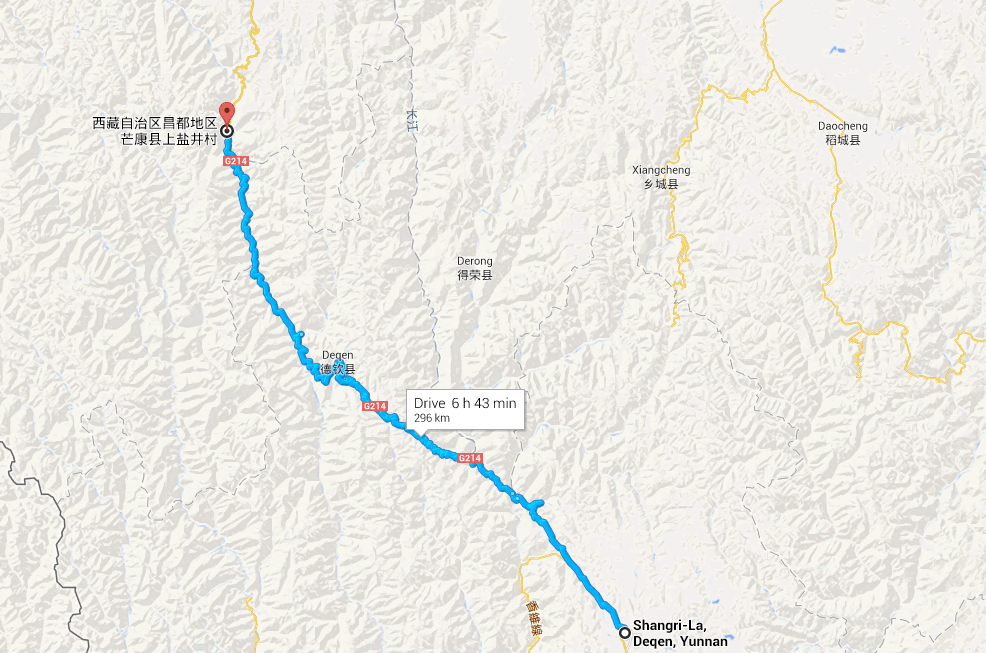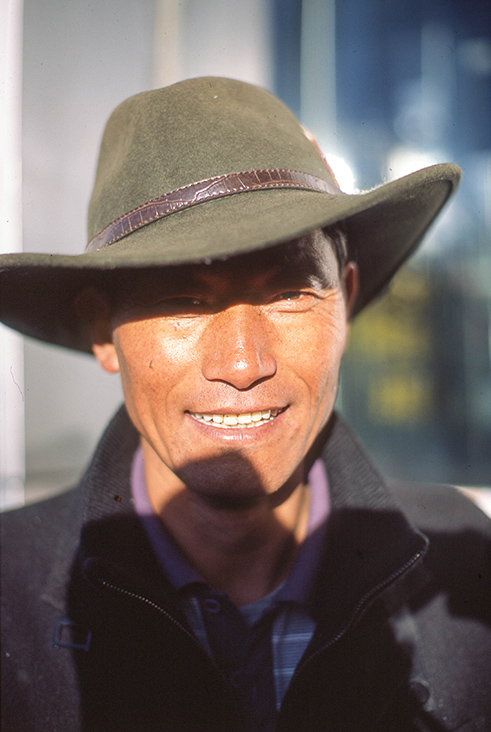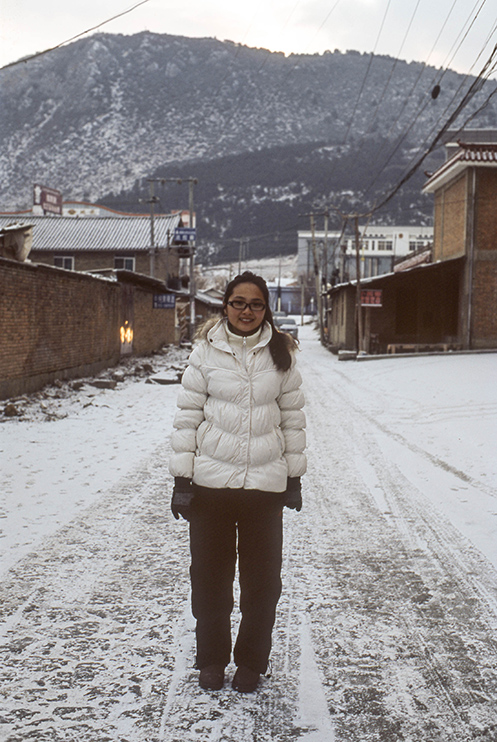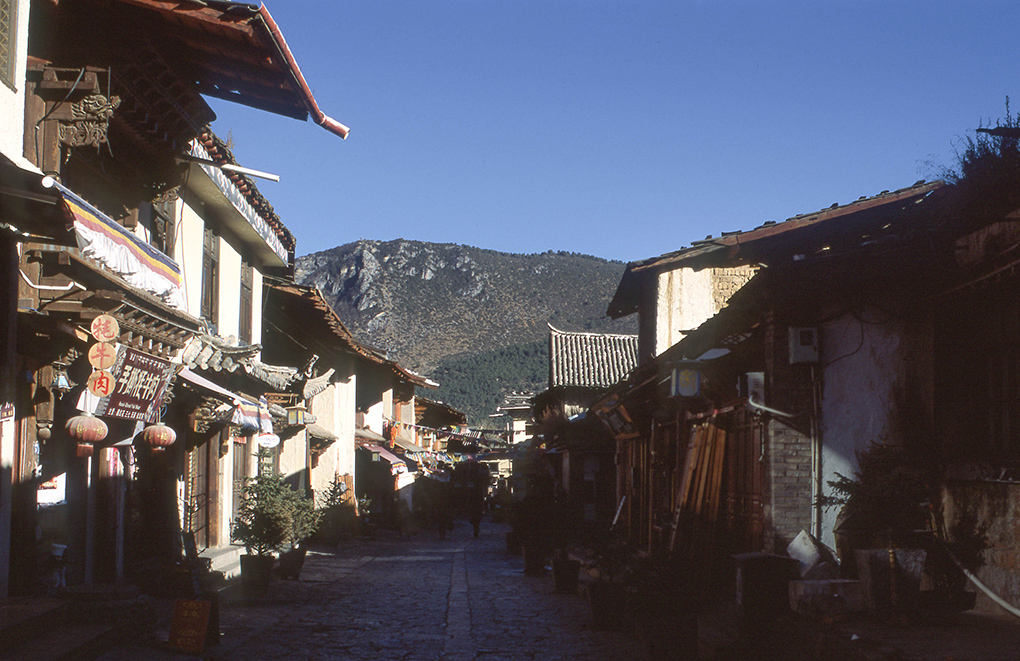Shangrila - Yan Jing
December 2013
"Nobody attempts Tibet in Winter"

There are many roads into Tibet - all are illegal for foreigners. For most travelers, their journey in Yunnan will end in Shangri-la. A few
more intrepid ones will test the limits by driving up to Diqin and end off the journey by snapping a few photos of the mystical
Kawa Karpo mountains. Beyond that, you reach defacto Tibet and the huge police presence is there only for you. There is no drug
smuggling in Tibet and no other cross-border crime for them to fret about other than the curious tourists.
I have to be careful with what I write here - for only good reasons. Along the way, I received assistance from many innocent others. Most
of the time, I lied in a certain way to get to the next stage of journey. Some of them eventually knew about my identity - that I was Singaporean and
hence they are putting themselves at risk. This travelogue is not an encouragement for others to attempt this route - but rather, to discourage
you from every attempting one - until China decides to open up Chamdo again and let others have a taste of its stark beauty.
The chances of you succeeding this journey like I did is remote. It was a little easier because I am ethnic Chinese,
but even the Koreans, foreign Chinese and Japanese make up the list of deportees from Tibet.
The journey starts in Shangri-La. Upon arrival, it feels just like any other small Chinese city except the obvious Tibetan architecture.
The majority of denizens are actual Tibetans, but somehow, their thinking and way of life is indubitably Chinese. The usual touts would greet you at arrival,
offering you a ride in their SUVs around Shangri-La for a small fee. My destination however was different from the usual.
I would ask them for directions and whether they could bring me in into Tibet, but the common answer is that they (the drivers and touts) themselves have
never been to Tibet before. For these Tibetans living in these quasi-Tibetan-Chinese cities, it was a real hassle for them to travel
back to their traditional homeland (even though the situation has vastly improved, ethnic Tibetans still requie permits before entering defacto Tibet).



The Shangri-La old town is a toned down version of the Lijiang metro-village. Nevertheless, it still features the usual touristy gamut. I
would recommend all travelers to get out of the Shangri-La itself and lose yourself in the surroundings (there were plenty of nice
Temples but I decided to head straight into Tibet)


A wild dog which resembles the famous Tibetan Mastiff. I believe this dog was probably a result of some mix-breeding amongst the ferals.


I cannot reveal some photographs here as it will implicate innocent parties involved. Let's just said that I finally made some arrangements
- mostly via a stroke of luck - for transport into Tibet. Have a look at the city of Shangri-La during that peroid - it was caked in
pure snow! Everyone we met urged us not to risk our lives by going Tibet during the winter months.

The next day involved some serious driving up mountains. Driving in Tibet is a deadly affair. Most of the roads are badly formed, badly
frozen, riddled with pot holes and there are no safety road lights. Make the wrong move at night anf you will going home in caskets.



The road into Tibet from Shangri-La goes through many mountains. At some peaks, you will find yourself somewhere close to 4800 metres. For
most parts of the journey, you would be traveling at 3500 metres. Mountain sickness is a real problem here. You will need to contact your
doctor before starting a journey like this. As a medical doctor, I did my due deligience and I was on chemical prophylaxis (acetazolamide) during
most of the journey. Identification and good suspicion of emerging signs of Acute Mountain Sickness is key in the management. Failure to quickly
descent means pulmonary oedema and brain oedema. Death quickly ensues. The nearest hospital here is hundreds of miles away. Do buy good
travle insurance as any evacuation is done via high mountain helicopters (but I sincerely doubt such a service exists here).





We were the only tourists in this lonely road in. Everyone else is either Tibetan (mostly truck or van drivers making deliveries) or going
home to some remote village. Occasionally, you would see a few drivers stuck deep in the snow. If you are unfortunate, you would see a vehicle
accident. Death is a very real topic here.

The trip to Yan Jing would take us 10 hours of continuous driving (with occasional breaks for photography) and it was already quite fast.
There is no one here to seal the roads if the conditions were not suitable for overland cruise. Most of our trip to Tibet were spent driving
in the vehicle except for the last day.
While I cannot reveal too much about the innocent, my driver despite being Tibetan had never been in Tibet. As a matter of fact, he mistakenly
called Lhasa "Tibet". So when we were asking directions in Tibet proper, the locals were wonder what he meant by "directions to Tibet" when
the roads he was driving on is already Tibet. We never made it to Lhasa of course, it would be sheer madness. The drive would require 15 days return
and the chances of making back alive and not arrested would be close to zero.
While I cannot specify what were our conversations, the driver who is born the same year as me has a more realistic view of society. Money
talks, he said. He was not aware of the Tibetan situation nor does he wants to know about it. For him, he loved the People's Republic of China
and that was enough for him.

Watch out for this sign post. This symbolizes the border between defacto Tibet and Yunnan province. Just 5 minutes of drive beyond,
you will reach your first Tibetan check point.

This is no exaggeration. I saw a few eagles soaring up in the sky as our vehicle climbed up towards the front gate of Yan Jing. Amazement
turned to horror as we were abruptly stopped by a metal gate. The police came towards our vehicle and asked everyone to step out and get
registered in their office.
They asked to see driver's papers. He had none; but he is ethnic Tibetan. They told him he can apply for a permit in the station. Kit Shan
is a Hong Kong citizen. She is free to move beyond. Then it comes to my turn. They asked for my Identification Card. I showed them my passport.
They were shocked. They asked why am I here. I lied to them that it has always been my dream to see Tibet. I lied that I was born in China but migrated
over to Singapore and hence I should be considered a Chinese subject. They took my passport and made calls to their superiors.
I was denied entry.
It was disappointing, but not unexpected. I came to terms during the journey to Yan Jing - I knew all along, having consulted many travel
agencies and websites, that I would be stopped in Yan Jing. Our vehicle made a turn and headed back to Yunnan. I felt sore, but does this have to be it?
It was already evening. We had to stop over somewhere before we drive back to Shangri-La. I studied the map and consulted my driver. It
was then that my driver decided to smuggle me in, via a different route. We stayed in Fo Shan for the night.

editor's note:
the photographs in this series are either digital (pentax k30, sigma 35/1.4, DFA 50/2.8, Tamron 10-24)
or analogue (Pentax ME Super, K50/1.4, assorted films including portras, provia, profotoxl)
home | travelogue | guestbook